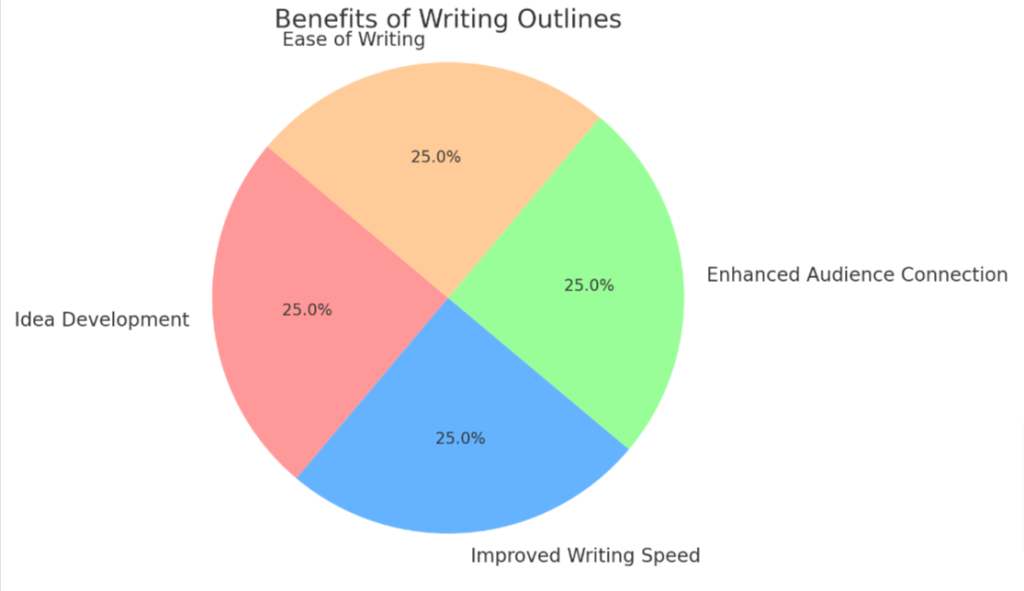The Importance Of Writing Outlines
Have you ever sat in front of your computer, staring at a blank document, unsure where to start? According to the National Survey of Student Engagement, nearly 50% of students struggle with organizing their thoughts before writing.
Our article presents an easy-to-follow guide on creating outlines that can help order your ideas and accelerate your writing process. Ready to learn more? Let’s dive into it!
Key Takeaways
- Outlining helps organize your thoughts and ideas in a logical order, making it easier to write cohesively and keep the audience engaged.
- Creating an outline before writing improves your writing speed by providing a clear roadmap to follow, saving time and eliminating writer’s block.
- Outlining enhances audience connection by ensuring that your ideas flow in a sequential manner, making it easier for readers to follow along and stay engaged.
What is an Outline and Why is it Important?
An outline is a tool used to construct and organize ideas in a logical and sequential flow, ensuring focused and cohesive writing.
Organizes ideas in logical order
Outlining gives structure to thoughts, making it easier to arrange them in a logical sequence. This top-down approach allows your ideas to flow naturally from one point to the next.
It helps ensure each argument or piece of information in your writing is relevant and connected, creating a smooth narrative that keeps the audience engaged. By visually mapping out the major points you want to hit, outlining eliminates any meandering paths or unnecessary details that may confuse readers.
Thus, an outline acts as a roadmap for your writing journey, helping both writer and reader stay on track.
Ensures focused and cohesive writing
Outlining your thoughts before writing gives you a clear roadmap to follow. It enforces focused and cohesive writing, keeping every paragraph relevant to the main idea. Each point on an outline represents a separate piece of information that forms a sequential flow in your essay or article.
This approach minimizes aimless wanderings in your content and maintains reader engagement.
A well-structured outline promotes strong connections between different elements of the text. Paragraphs smoothly transition from one to another, making it easier for readers to follow along with the writer’s thought process.
The outline serves as a framework ensuring each part contributes meaningfully towards reaching the conclusion.
Benefits of Outlining
Outlining helps with idea development, improves writing speed, enhances audience connection, and makes the writing process easier.
Helps with idea development
An outline jumpstarts idea development by creating a space for the thoughts and concepts that fuel your writing. It acts like a brainstorming platform where you can explore, classify, and refine your ideas before incorporating them into your paper.
You may start with broad points then narrow down to detailed sub-points under each main point. This process aids in building strong arguments or narratives for your writing project, making it more compelling and organized.
Moreover, it helps in identifying gaps in knowledge or argument flow which can be addressed early on in the drafting stage, resulting in high-quality work.
Improves writing speed
Outlining your writing can significantly improve your writing speed. By organizing your thoughts and ideas beforehand, you’ll have a clear roadmap to follow, allowing you to write more efficiently.
With an outline, you won’t waste time trying to figure out what comes next or how to transition between paragraphs. Instead, you can focus on expressing your ideas effectively and concisely.
By eliminating the need for constant decision-making during the writing process, outlining streamlines your workflow and helps you complete your work in less time.
Enhances audience connection
Outlining your writing not only helps with organizing and structuring your ideas, but it also enhances the connection you make with your audience. By having a clear outline, you can ensure that your thoughts flow in a logical sequence, making it easier for readers to follow along.
This sequential approach helps maintain their interest and engagement throughout your piece. Additionally, an outline allows you to strategically place relevant information at appropriate points, strengthening the impact of your message on the reader.
With a well-structured outline, you can create smoother transitions between paragraphs and sections, ensuring that your audience stays connected from start to finish.
Makes writing easier
Creating an outline for your writing makes the process easier. By structuring your thoughts and organizing them in a sequential manner, you can ensure that your ideas flow logically and cohesively.
With an outline, you have a roadmap to guide you through the writing process, making it easier to stay focused on your main points and subtopics. This helps eliminate writer’s block and saves time in the long run by providing a clear direction for your essay or article.
So, don’t skip this important step – outlining will make your writing journey smoother and more enjoyable.

Tips for Creating an Effective Outline
To create an effective outline, start with a central idea and use bullet points or numbering to include main points and sub-topics. This will help you organize your thoughts in a logical order and ensure your writing flows smoothly.
Read on for more tips on how to construct a well-structured outline that will make your writing impactful.
Start with a central idea
Start your outline by identifying a central idea. This will serve as the foundation for your writing and ensure that all of your points are relevant and focused. Think about what you want to convey to your readers and choose a main topic or theme that encapsulates this idea.
Starting with a central idea will help you maintain a clear structure throughout your writing and keep your thoughts organized in a sequential flow. By beginning with a strong foundation, you can create an impact on your audience and effectively communicate your message.
Use bullet points or numbering
To create an effective outline, you can use bullet points or numbering. This helps in organizing your thoughts and ensuring a clear structure in your writing. It allows for easy identification of main points and subtopics, making it easier to maintain focus and flow in your essay. Bullet points or numbering also help to create a visually appealing layout that enhances readability.
Include main points and sub-topics
An effective outline should include the main points and sub-topics of your writing. This helps to construct a clear structure and sequential flow of relevant information in your essay or article.
By organizing your ideas in this way, you ensure that your writing stays focused and impactful, with smooth transitions between paragraphs. Including main points and sub-topics also provides a framework for developing your thoughts and making connections with your audience.
So, whether you’re outlining for academic or creative writing, don’t forget to include these essential elements to enhance the clarity and impact of your work.
Conclusion
Writing outlines is crucial for organizing and structuring your ideas in a logical and sequential manner. It helps ensure that your writing remains focused, cohesive, and impactful.
By creating an outline, you can easily see the connections between different paragraphs, main points, and subtopics, enhancing the overall clarity and flow of your writing. So start outlining today and experience the benefits it brings to your writing process!

